If you scour the interwebs, you’ll soon find that there are volumes written on the process of visiting Yellowstone. Each guide is stuffed with advice concerning what to see and when to see it. Some guidebooks even give you an itinerary to follow as you wade through the mobs of people at each of the popular stops around the park. This is all well and good… but there may just be a better way…
Here is what you’ll want to know when visiting Yellowstone National Park.
Guide to Yellowstone
Visiting Yellowstone
Yellowstone National Park is a destination like no other. Spanning across three states (Wyoming, Montana, and Idaho) and covering over 2.2 million acres, Yellowstone is home to diverse wildlife, dramatic geothermal features, and breathtaking landscapes. If you’re planning a trip to this iconic park, here’s everything you need to know to make the most of your visit.
Where is Yellowstone?
Yellowstone National Park is located primarily in the northwestern corner of Wyoming, where the park boundary also extends ever-so-slightly into the neighboring states of Montana and Idaho. The park is a roughly 10-hour drive from Salt Lake City, Utah and a 12-hour drive from Denver, Colorado.
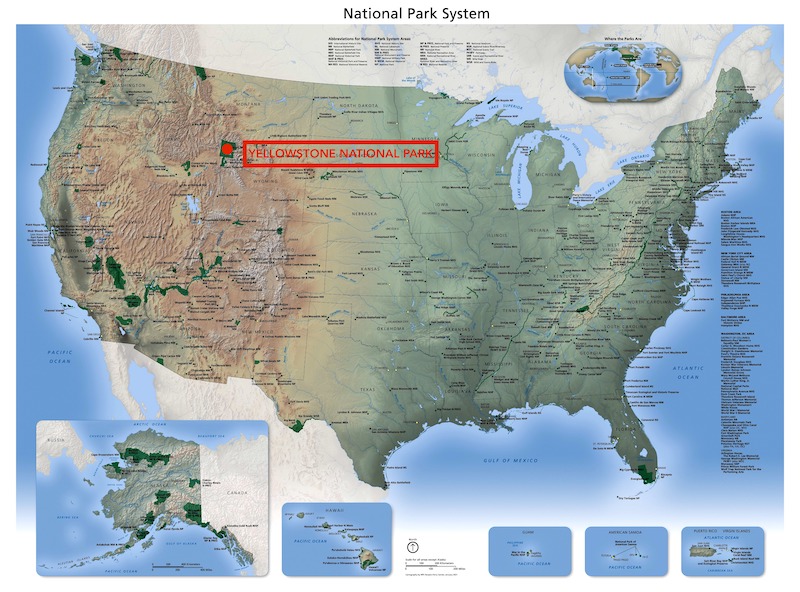
For the jet-setters among us, the nearest airport is Yellowstone Airport in West Yellowstone, Montana, but most visitors fly into Jackson Hole Airport in Wyoming or Bozeman Yellowstone International Airport in Montana. If you’re bringing in your own jet, you’ll probably just tell your private pilot to take you to Yellowstone… That’s what you pay them for anyway.
MOREThe park has six entrances, five of which provide access to the Grand Loop Road. This map shows each of these entrances, which are described in greater detail below.
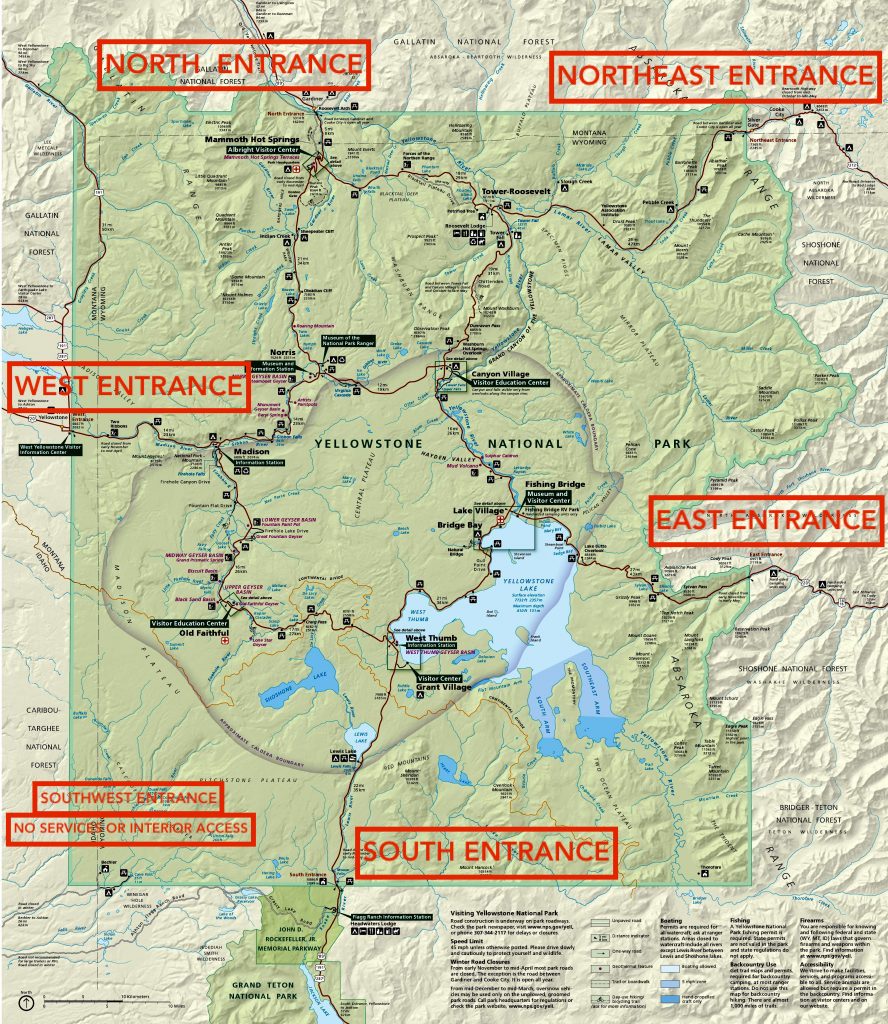
North Entrance: The North Entrance is located in Gardiner, Montana, and is the only entrance that is open year-round. This entrance provides access to Mammoth Hot Springs, and a fork in the road, which allows motorists to travel toward the Norris Geyser Basin or Tower-Roosevelt, Lamar Valley, and toward the Northeast Entrance.
Northeast Entrance: The Northeast Entrance is located near Cooke City, Montana, and is open seasonally from late May to early November. This entrance provides access to the Lamar Valley, and Tower-Roosevelt. Outside the park at this location, travelers can hit the Beartooth Highway or the Chief Joseph Highway, which leads to the cowboy capitol of Cody, Wyoming.
East Entrance: The East Entrance is located near Cody, Wyoming, and is open seasonally from early May to mid-October. This entrance provides access to Yellowstone Lake, Fishing Bridge, and some nice mountain hiking options such as the Avalanche Peak Trail.
South Entrance: The South Entrance is located north of Jackson, Wyoming, and its signature destination, Grand Teton National Park. This entrance is open seasonally from early May to mid-October. The southern entrance provides easy access to the West Thumb Geyser Basin, as well as Old Faithful and its Upper Geyser Basin.
West Entrance: The West Entrance is located in West Yellowstone, Montana, and is open seasonally from late April to early November. This entrance provides the most direct access to the majority of the park’s thermal features. Norris Geyser Basin, the Upper, Middle and Lower Geyser Basins are all within 30 miles of the West Entrance.
Southwest Entrance: This remote and little-known entrance leads to the Bechler Ranger Station, and provides access to some of the park’s more remote trails. This entrance DOES NOT provide access to the Grand Loop Road, and is only used by those wishing to recreate in the remote Bechler area.
Entrance Fee and Pass Information
Visitors to Yellowstone National Park are required to pay an entrance fee. The fee as of 2023 is $35 per vehicle for a 7-day pass, $30 per motorcycle for a 7-day pass, and $20 per person for a 7-day pass for visitors entering the park on foot, bike, or skiing. Visitors can also purchase an annual pass for $70, which grants access to Yellowstone National Park for one year from the date of purchase.
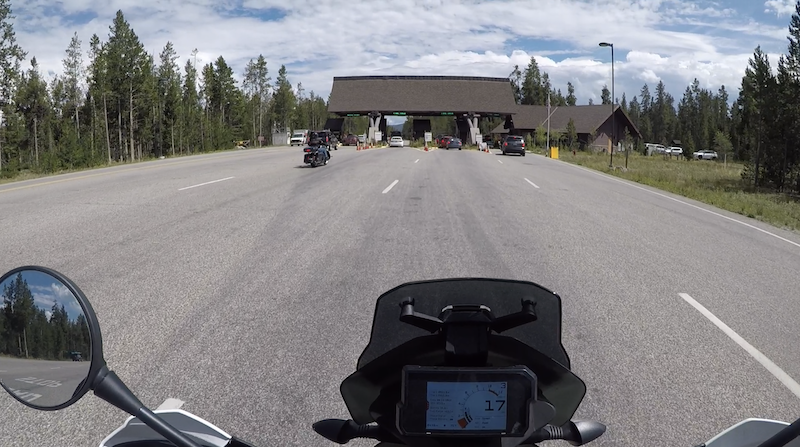
As a Park Junkie, you already have the National Parks Pass, aka the Interagency Pass. It’s only $80 and is one of the best purchases you’ll make this year. It grants entrance to more than 425 national park service units and is an economic necessity for those who make it a practice to visit multiple parks in a calendar year.
MOREYou may also access the park with a Military Pass, Annual 4th Grade Pass, a Senior Pass, an Access Pass or a Volunteer Pass.
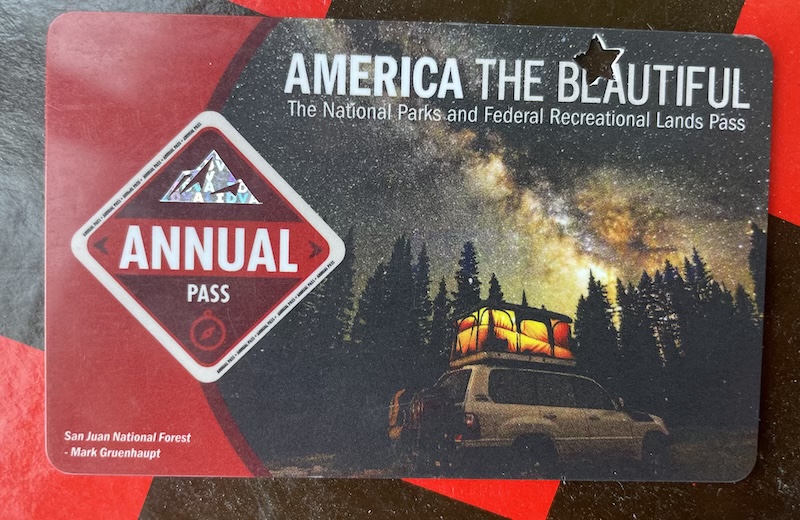
These passes can be obtained at the gate to most national park units and can also be ordered online at https://store.usgs.gov/pass.
If this idea doesn’t turn you on, prepare to spend $35 to enter the park. It should be stated, that Park Junkie writes fortune cookies on his days off, and he predicts this fee will certainly increase, much like postal rates and taxes…
For current entrance fees in Yellowstone National Park, check out the park’s entrance fee page.
Visitor Centers in Yellowstone
Yellowstone has a number of visitor centers in which guests can gather up-to-date information about the park’s current happenings. Make a habit of stopping by the visitor centers as you enter parks, you may just save yourself a headache by learning of potential closures or areas of concern.
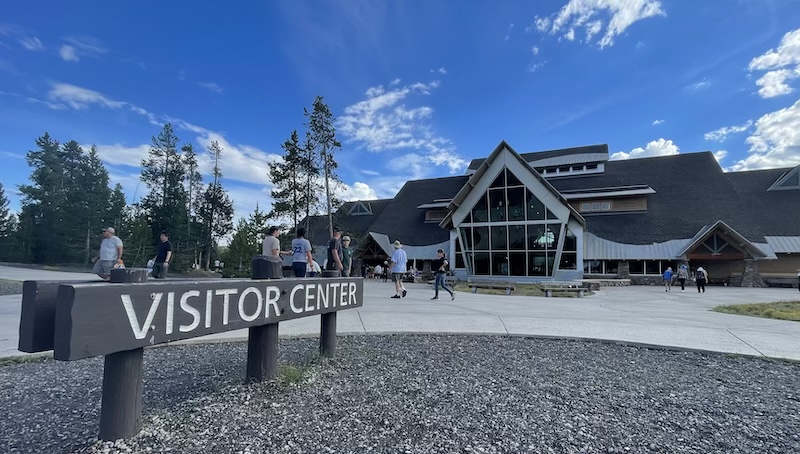
Some of the park’s visitor centers are small, and offer little information, while a couple can leave visitors with information overload. Here are a list of Yellowstone’s Visitor Centers:
MOREYellowstone has 6 actual visitor centers, two of which are considered “visitor education centers”, those being the Canyon & Old Faithful Visitor Education Centers. These contain the largest volumes of information available to guests. The Albright, Grant and Fishing Bridge Visitor Centers are smaller, yet contain informational exhibits and access to rangers who can answer questions and provide information on current park conditions. A complete list of visitor centers, with links is provided below the map.
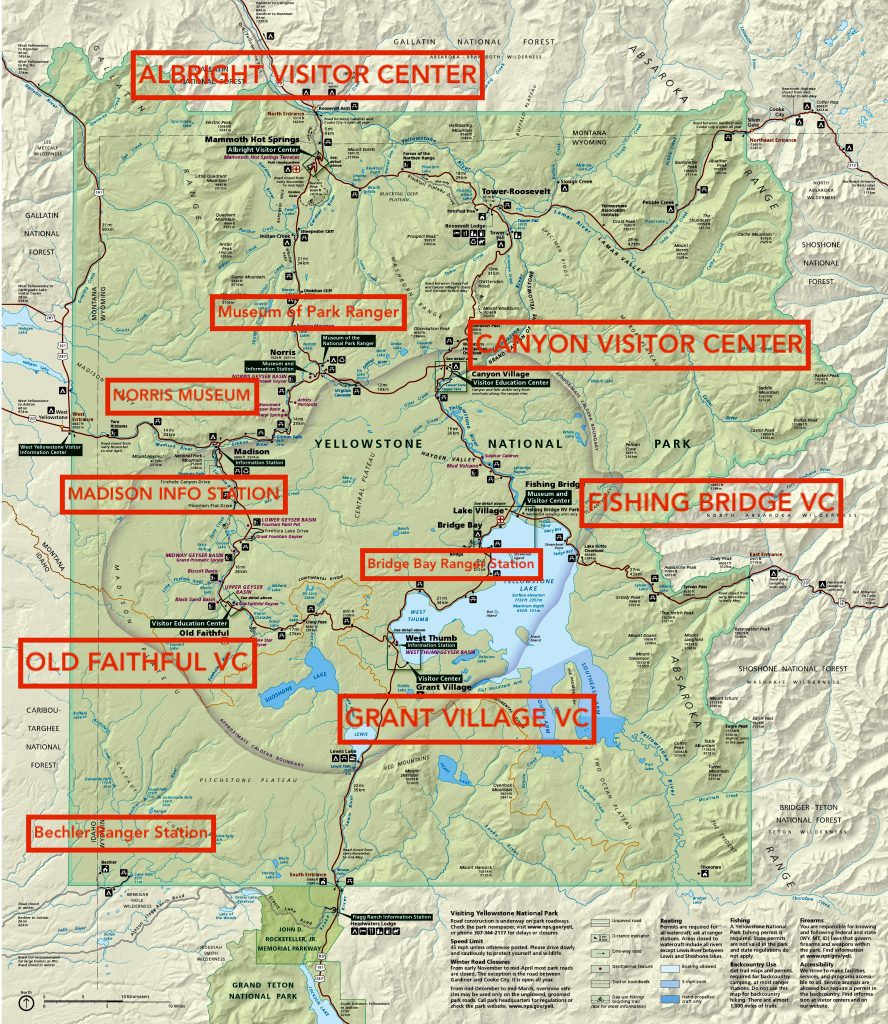
Horace Albright Visitor Center: Located in Mammoth Hot Springs, this visitor center provides information on the park’s history and geology, and features exhibits and educational programs.
Canyon Visitor Education Center: Located near the Grand Canyon of the Yellowstone, this center offers exhibits on the park’s geology, ecology, and wildlife. It also offers ranger-led programs and educational displays. This is likely the most complete visitor center in the park, with the possible exception of the Old Faithful Visitor Center.
Fishing Bridge Visitor Center: Currently closed as of 2023, although a small roadside cabin is staffed most days with a ranger who can provide information on local trails and current conditions.
Grant Village Visitor Center: Located near Yellowstone Lake, this center offers exhibits on the park’s natural and cultural history, as well as ranger-led programs and educational displays.
Old Faithful Visitor Education Center: Located near the park’s most famous geyser, this visitor center is open year-round and provides information on the geological features and thermal activity of the park, as well as wildlife, history, and recreational opportunities. The visitor center has interactive exhibits, including a seismograph that tracks earthquake activity in the park, as well as a relief map of the park’s volcanic caldera. This and the Canyon Visitor Center are the largest in the park.
Madison Information Station: This small stone building is situated next to the confluence of the Gibbon and Firehole Rivers, and marks the beginning of the Madison River. The center is staffed most days and offers information on park activities and events, as well as exhibits on the park’s geology, ecology, and wildlife.
Norris Geyser Basin Museum: This small structure offers a few exhibits on the park’s geothermal features, as well as occasional ranger-led programs and educational displays.
Museum of the Park Ranger: This old log structure was originally constructed as a US Army outpost built in 1908. Today, this visitor center houses exhibits that celebrate the history of the park ranger and is staffed by volunteer retired rangers.
Bechler Backcountry Office: The remote Bechler backcountry ranger station is probably the least visited such office in the park. Not many services are available here, although permits and fishing licenses may be acquired here & there is a ranger on hand if one is needed. The office is open daily during summer months from 8am to 4:30pm.
Seasonal Concerns
Yellowstone is open year-round, but the park experiences extreme weather conditions throughout the year. Those with any time under their belt here, will tell you: No matter when you’re visiting Yellowstone, come prepared for any kind of weather, because mother nature can seem downright crazy here!
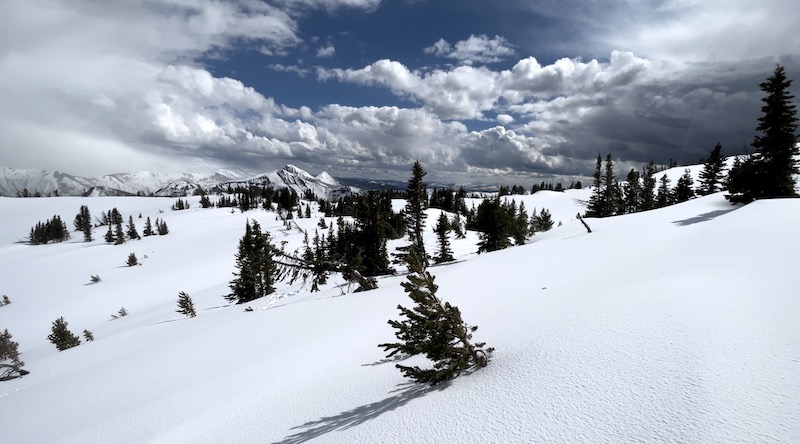
With four distinct seasons, each brings its own charm, scenery, and activities. Winter brings a blanket of snow and a peaceful serenity to the park, while spring brings vibrant blooms and the chance to witness newborn wildlife. Summer is the busiest time of year, with warm temperatures and endless opportunities for outdoor recreation. Finally, autumn brings stunning displays of fall colors and a quieter park experience.
MORESpring is a transitional season in the park, with unpredictable weather and the potential for snow and ice on roads and trails. This is a favorite time of year for Park Junkie in Yellowstone. Everything is just waking up and getting back to the business of life, after the long, hard freeze of the park’s brutal winter. A favorite location for observing the springtime thaw, is right on the shores of Yellowstone Lake, the breaking ice of which provides a dreamy landscape that is found in few other places.
Summer is the busiest time of year, with crowds and long wait times at popular attractions. It’s also the warmest time of year, with average temperatures ranging from 70-80°F. Don’t let this fool you into not bringing appropriate attire, as the weather in Yellowstone can quickly turn into an unprepared visitor’s worst nightmare. Snow and freezing temperatures are not uncommon during summer months. Come prepared for a chilly affair, and you may just be quite thankful that you did.
Fall is a quieter time to visit, after the majority of summer’s family crowds have returned home for school and the hum drum of daily like. For the rest of us, this provides a great shoulder season, with cooler temperatures, changing leaves and the opportunity to see wildlife in the midst of their fall rutting season. Definitely bring your layers, as the fall in Yellowstone can be downright frigid!
Winter is a magical time to visit, with fewer crowds and the chance to see the park covered in snow. However, most areas of the park are closed to vehicle traffic during the winter months, as only the Mammoth Hot Springs entrance allows vehicle access, mainly in order to provide passage to residents of Cooke City, Montana, just outside the park’s northeast entrance. This provides those with a capable vehicle of accessing Lamar Valley during the winter, which is pretty cool. For access to the park’s other accessible areas, visitors must rely on snowmobiles or other specialized vehicles to get around.
Pet Regulations
Pets are allowed in Yellowstone National Park, but they must be kept on a leash no longer than six feet at all times. Pets are not allowed on boardwalks, trails, or in the backcountry. Additionally, pets are not allowed near thermal areas or within 100 feet of any body of water. Visitors should also be aware that bears, wolves, and other wildlife may view pets as prey, and should take precautions to keep their pets safe.

Many people choose to travel with their pets, and understandably so. The make pretty good companions, and they don’t complain too much. Nevertheless, a trip to Yellowstone may not be the most enjoyable journey for the family dog, or any other pet for that matter. There’s just not much for pets to do in most parks.
MOREIt is probably best to leave your pets at home, with a good sitter. Plenty of pet sitting services are available, in nearly every area of the US. If you are traveling with your best friend, and have no comfortable accommodation for them, such as a large air conditioned RV (it is illegal to leave your pet in a vehicle for any amount of time in Yellowstone), there are a number of sitting services available in the park’s surrounding communities.
Below are a couple of options. I have never used any of these services, so do your research.
Lodging Options
There are nine lodges within Yellowstone National Park, altogether providing more than 2,000 rooms. Accommodations range from rustic cabins to modern hotels. The lodges are operated by Xanterra Parks & Resorts and offer a range of amenities, including restaurants, gift shops, and guided tours.
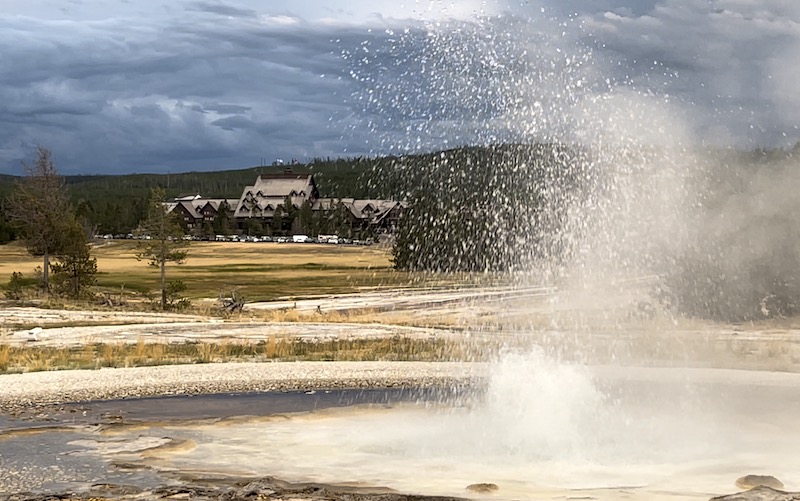
Reservations for lodging within the park can be made up to 18 months in advance and are highly recommended, particularly during peak season. All of the park’s lodging options are listed below.
MOREYellowstone’s lodging options are generally confined to the park’s six small villages, all of which are located along the Grand Loop Road, and provide visitors the opportunity to spend a night or three in the world’s first national park. This map shows the location of each lodging option, all of which are listed below, along with links to a reservation system so you can book your stay today.
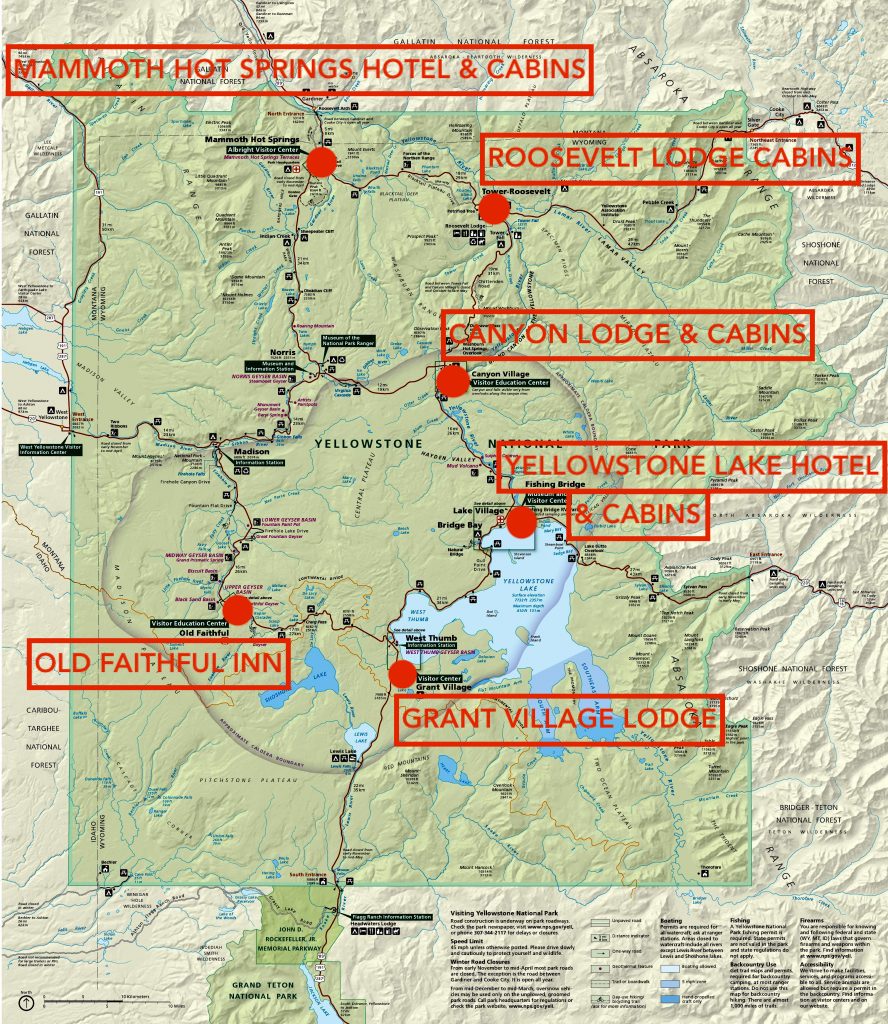
Mammoth Hot Springs Hotel and Cabins also offer both hotel room-style lodgings and cabins in a large lodge.
Roosevelt Lodge Cabins provides rustic cabin accommodations in a more laid back setting. No wondering which fork to use here.
Canyon Lodge and Cabins offer over 400 guest rooms in 5 hotel-style lodges and over 100 cabins for more rustic lodging.
Yellowstone Lake Hotel and Cabins provide a wide range of accommodations, including hotel room-style lodgings and cabins. Lake Lodge Cabins offer 186 cabin options.
Grant Village Lodge features 300 guest rooms in 6 two-story hotel-style lodges.
Old Faithful Inn is a rustic lodge that provides hotel room-style accommodations, while Old Faithful Lodge Cabins offers comfortable cabin lodgings.
Old Faithful Snow Lodge is a larger lodge with a mix of hotel room-style and cabin accommodations.
Camping Options
Camping in Yellowstone National Park is a popular way to experience the park’s natural beauty and wildlife. The park offers a variety of camping options, from primitive backcountry camping to RV camping with full hookups.
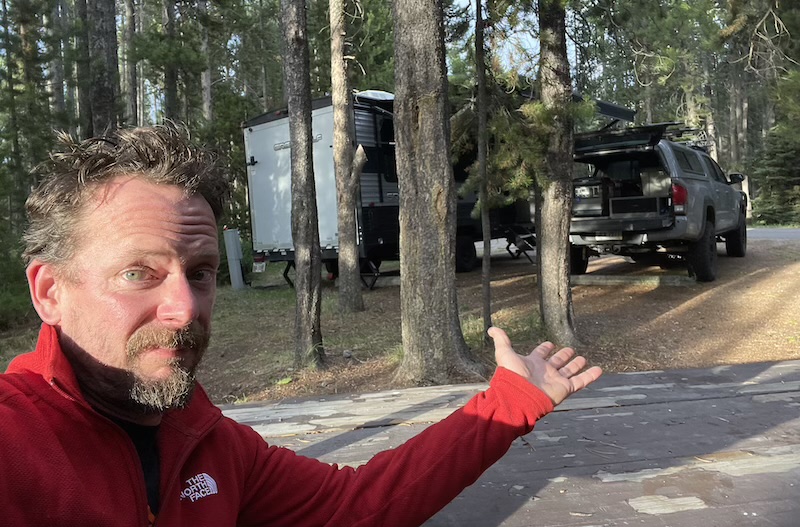
Since most campsites are booked well in advance, it is advisable to make reservations as early as possible, and opening dates are subject to change as conditions dictate.
MOREYellowstone National Park has a total of 12 campgrounds and provides more than 2,000 established campsites. To secure a campsite, visitors must reserve in advance, except for the Mammoth Campground which offers first-come, first-served sites from October 15 to April 1.
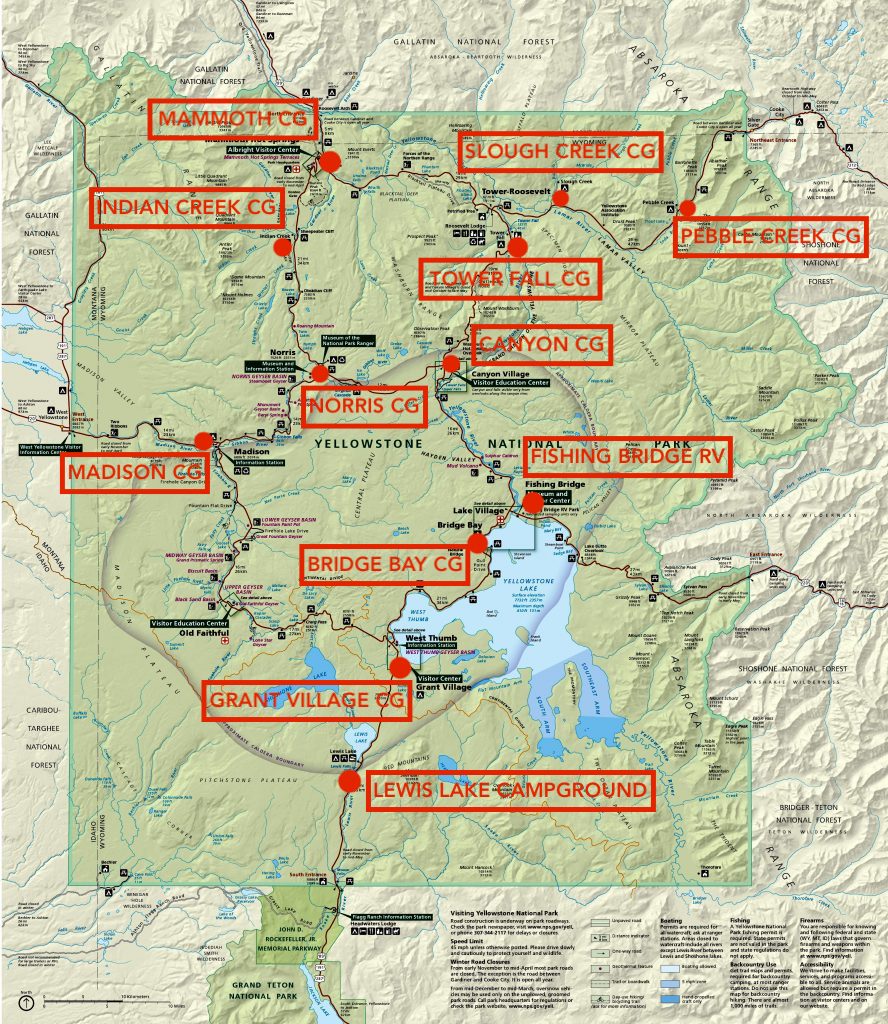
Mammoth Campground – Mammoth Campground, situated at an elevation of 6,200 feet (1890 m), is the only campground in the park that operates throughout the year. It is positioned five miles south of the North Entrance and has scattered juniper and Douglas fir trees, which offer shade during summer.
Tower Fall Campground – The Tower Fall Campground is situated at an elevation of 6,600 feet (2012 m) on the north side of the exciting road to Dunraven Pass, the highest pass in the park. The campground is in close proximity to the Tower General Store and the Tower Fall. The Lamar Valley lies just to the east, which provides a fantastic opportunity to view wildlife, is located nearby along with numerous hiking trails. Additionally, Roosevelt Lodge, which is a short drive away from the campground, offers horseback riding and dining services.
Slough Creek Campground – This campground is situated in close proximity to Lamar Valley, or America’s Serengeti, which provides some of the finest wildlife viewing spots in the park. It is located at the terminus of a two-mile dirt road and is primarily suitable for tents and small recreational vehicles. The surrounding area offers a plethora of opportunities for hiking and fishing, including the Slough Creek Trail that commences nearby. The campground sits at an elevation of 6,250 ft (1905 m).
Pebble Creek Campground – Situated at an elevation of 6,900 feet (2103 m) and adjacent to the stunning Absaroka Mountains, the Pebble Creek Campground provides visitors with a secluded camping experience near the park’s Northeast Entrance. There are numerous opportunities for day hikes available in the vicinity, and fishing enthusiasts can explore the nearby Soda Butte Creek. Additionally, the Lamar Valley provides exceptional wildlife viewing opportunities.
Canyon Campground – Located in a lodgepole pine forest at Canyon Village and at an elevation of 7,900 feet (2408 m), the Canyon Campground is situated in close proximity to the awe-inspiring Grand Canyon of the Yellowstone River. Canyon Village is just across the road, and provides visitors with access to stores, restaurants, and lodging. There are several nearby hikes, including the Cascade Lake and the Canyon Rim trails.
Fishing Bridge RV Park – Fishing Bridge RV Park sits at an elevation of 7,800 feet (2377 m) and is located near the Yellowstone River at its point of exit from the massive Yellowstone Lake. This is the only campground in Yellowstone to offer water, sewer, and electrical hookups, but they really pack ’em in here. No tents or tent campers are allowed. The Fishing Bridge Village offers food, fuel and basic services.
Bridge Bay Campground – The Bridge Bay Campground is situated at an elevation of 7,800 feet (2377 m) and is located in close proximity to Yellowstone Lake, the largest high-elevation (above 7000ft) freshwater lake in North America. Also found here is the Bridge Bay Marina, which offers a small store, boat tours on Yellowstone Lake, fishing charters and boat ramps. Campers here enjoy breathtaking views of the lake, wandering bison and elk, and stunning sunsets over the Absaroka Range.
Grant Village Campground – Nestled in Grant Village and positioned at an elevation of 7,800 feet (2377 m), the Grant Campground is conveniently located just off the Grand Loop Road at the south end of Yellowstone Lake. As one of the larger campgrounds in the park, it offers group and wheelchair accessible sites. Visitors can also take advantage of nearby amenities, such as stores, a restaurant, gas station, visitor center, and boat ramp.
Lewis Lake Campground – The Lewis Lake Campground is positioned at an elevation of 7,800 ft (2377 m) and is located approximately eight miles north of the South Entrance, within close proximity to the southeast shore of Lewis Lake. The campground provides convenient access to a nearby boat ramp. Visitors can utilize canoes, kayaks, and motor boats on Lewis Lake, provided that they obtain a boat permit and receive an aquatic invasive species inspection conducted by park personnel.
Madison Campground – At an elevation of 6,800 feet (2073 m), the Madison Campground is situated approximately 14 miles east of the town of West Yellowstone and 16 miles northwest of Old Faithful. The campground is located in close proximity to the confluence of the Gibbon and Firehole rivers, which merge to form the Madison River in the meadows below National Park Mountain. During the early summer, the surrounding meadows are abundant with wildflowers and bison.
Norris Campground – The campground, situated at an elevation of 7,500 feet (2,286 m), is adjacent to a vast meadow that offers excellent wildlife viewing opportunities. The campground is frequently visited by bison, and most campsites are shaded by lodgepole pine. The Museum of the National Park Ranger, Norris Geyser Basin Museum, and the hottest and most variable thermal area in Yellowstone, Norris Geyser Basin, are all within a short walking distance from the campground.
Indian Creek Campground – Situated at the foot of the Gallatin Mountains and presenting magnificent views of the appropriately named Electric Peak, Indian Creek Campground is situated about eight miles south of Mammoth Hot Springs on the way to Norris, at an elevation of 7,300 feet (2225 m). The campground provides an effortless approach to fishing and hiking, while also being away from the main road, rendering a more peaceful, unsophisticated experience than many other sites.
Guide to Yellowstone
Relevant Links
National Park Guides

All content found on Park Junkie is meant solely for entertainment purposes and is the copyrighted property of Park Junkie Productions. Unauthorized reproduction is prohibited without the express written consent of Park Junkie Productions.
YOU CAN DIE. Activities pursued within National Park boundaries hold inherent dangers. You are solely responsible for your safety in the outdoors. Park Junkie accepts no responsibility for actions that result in inconveniences, injury or death.
This site is not affiliated with the National Park Service, or any particular park.
